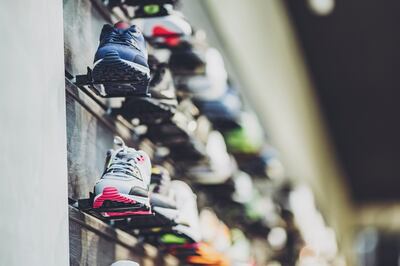
Humans have run for hundreds of thousands of years, most without the benefit of cushy, brightly coloured footwear. But take a stroll around a sports shop or scroll through a running website, and you’ll find a dizzying array of options. Some promise speed, others comfort and injury reduction – and nearly all carry hefty price tags.
To help you sort fact from fad – and stability shoes from super shoes – we consulted research and experts.
What makes a running shoe a running shoe?
Traditional running shoes are designed to blunt the impact of hitting the ground and provide traction, Geoff Burns said, a sport physiologist for the US Olympic and Paralympic Committee in Colorado Springs, Colorado.
Runners are made of fabric, foam and rubber, but they’re engineered to meet the specific demands of running. For instance, they’re typically lighter and more flexible than basketball shoes, which are designed to protect your foot during lateral, stop-and-start movements.
READ MORE
The biggest difference in most running shoes is in the midsole, made of cushy foam. Other types of athletic sneakers have midsole foam, but there’s more in running shoes and manufacturers say it’s tapered toward the front of the shoe to assist with forward motion, Burns said.
In addition, most running shoes have features integrated into the uppers – the fabric parts that make up the top of the sneaker – meant to keep your foot secure, Matthew Klein said, founder of the “Doctors of Running” website and podcast. You might notice a stiff piece of cardboard or plastic on the back of the sneaker called a heel counter, for instance, or extra strips of fabric, called overlays, that run across the upper.
Do specialised running shoes actually do what they claim?
Shoe companies invest a great deal of money in biomechanical research, Allison Gruber said, an associate professor of kinesiology and a biomechanics researcher at Indiana University Bloomington.
However, marketing departments and running shop assistants often oversell certain features, especially to newer runners, said Klein and Dr Kevin Vincent, a physiatrist.
Stability and motion control shoes, for instance, are popular among runners and are said to prevent injury by correcting for over-pronation – when your ankle collapses too far inward as you walk or run. Some models have rigid posts that reduce side-to-side motion, though many newer releases use subtler systems, such as making the shoe wider on the bottom than the top, Klein said.
But current evidence doesn’t bear out their protective benefits. Pronation itself is a natural part of your running gait. “That’s how your body dissipates force,” Vincent said. Overcorrecting it may cause knee and hip pain, and prevent you from properly using and strengthening muscles in your foot and leg.

Excessive pronation can pose problems, too, but it’s poorly defined: “What might be excessive for one person isn’t necessarily excessive for another,” Gruber said. In other words, the shoes may present a solution to a problem that a runner might not have, and most people would be better off allowing their foot to move more naturally, Vincent said.
Maximalist shoes, which have thick soles purporting to better cushion your foot from impact, are another popular category. Some also have rocker bottoms, curved up in the front and back, which guide your foot forward. But while cushioning can soften the blow, more foam isn’t always better, Vincent said.
With a thicker pile of foam between your foot and the ground, your brain receives less information about how your body is interacting with the surface beneath you, Vincent said. This might make you more likely to wobble or even strike the ground harder than you would in a less-cushy shoe. Some impact is absorbed by the foam, but the rest travels up to other areas, including the knee and hip, potentially worsening any pain prevalent in those areas.
Ultimately, the idea that any running shoe can prevent you from getting hurt doesn’t hold water. Rates of running-related injuries, such as shin splints and stress fractures, have remained high over the past 40 years – despite evolving shoe technology. And a Cochrane Review published in 2022 assessed 11,240 runners across 12 randomised controlled trials, most of which compared different types of running shoes to each other. The analysis found no evidence that running shoes, or prescribing certain shoes by type, have injury-preventing properties.
There are also super shoes, trendy racing sneakers with stiff, carbon-fibre plates and ultra lightweight and responsive foam. Several studies suggest that, while wearing them, serious athletes run faster by improving their running economy – or the amount of oxygen required to run a certain pace.
Above all, make sure your shoes feel comfortable
— Matthew Klein said
But super shoes don’t work for everyone: In a small study conducted by Burns and his colleagues, super shoes worked to improve running economy for some runners at non-elite speeds, but about one-third had worse running economy in them. There’s not much research about super shoes and injury, but many experts believe that while they might not necessarily increase injury risk compared with other types of shoes, they might shift the ways runners get hurt, Klein said.
That’s why he and others recommend steering clear of super shoes when you’re starting out.
What should you look for in running shoes?
Most runners – including those who are lacing up for the first time – should consider opting for what’s known as a neutral daily trainer, Klein said. These shoes don’t attempt to change the way your foot interacts with the ground – they simply place some cushioning between the two.
But there are a few reasons to consider other options. While specialised shoes, such as maximalist and stability sneakers, don’t seem to ward off running injuries, clinicians like Klein and Vincent said they sometimes recommend them to patients who are already coping with certain types of pain or injury.
If, for instance, you have arthritis, plantar fasciitis or other types of pain in your feet, maximalist shoes – especially those with rocker bottoms – may help, since there is some evidence that they might decrease the pressure on your feet and the demands on your Achilles and ankles. In these cases, consider seeing a sports medicine provider, who can guide you on treatment and prevention.
And if you regularly log distances on craggy, muddy or steep terrain, trail shoes have added traction for better grip, especially on downhills, Klein said. Some also have a stiff plate embedded into the midsole to protect your foot from sharp rocks.
And, above all, make sure your shoes feel comfortable, he added. Comfort, more than matching your shoe to your gait or foot type, is what will keep you running over the long term, he said.
Running shoes are expensive. How often should I really replace them?
Studies conducted in the lab and in the real-world suggest running shoes do lose significant amounts of shock absorption within 500 to 800 kilometres, if not earlier. That’s about three to five months if you’re a serious runner, or perhaps around nine to 12 months, if you’re getting out there a couple times per week, said Hiruni Wijayaratne, an elite marathoner and running coach.
But it isn’t clear when this breakdown begins causing problems for your feet or legs, Burns said.
Much depends on the runner and the shoe, he said. Higher-mileage runners, those who train on harder or rugged surfaces, or people with uneven gait patterns may have to replace shoes sooner, and super shoes tend to break down faster than neutral trainers.
If you’re accustomed to running, you might feel when your shoe is nearing retirement – perhaps your arch or shins ache slightly, or your knees or heels grow sore. Visible signs of damage, such as cracks or worn-through rubber, also indicate it’s time to move on, Vincent said.
You can extend a shoe’s life by wearing it only for running and not to other workouts or the grocery store, Burns said. And if you have the funds, alternating between pairs helps too, by allowing at least 24 hours for the foam to restore its shape. There’s also some evidence that cycling through more than one model – whether it’s in a different category, or a similar style in different brands – reduces injury risk, perhaps because it slightly varies the repetitive stresses on your body.
Finding the right sneaker can feel daunting, but don’t stress too much about getting one perfect pair, Burns said. Instead, recognise there’s likely a range of shoes that will work for you – and the search is all part of the running journey. – This article originally appeared in the New York Times














